HOME |EXHIBITION |STAGE | REPORT
Works and commentary
◼︎The number below this page corresponds to the number of the map.
◼︎The pictures and the images below are reference.
Prologue
Main Visual: Q-Ring
Yasuhito Nagahara
2025
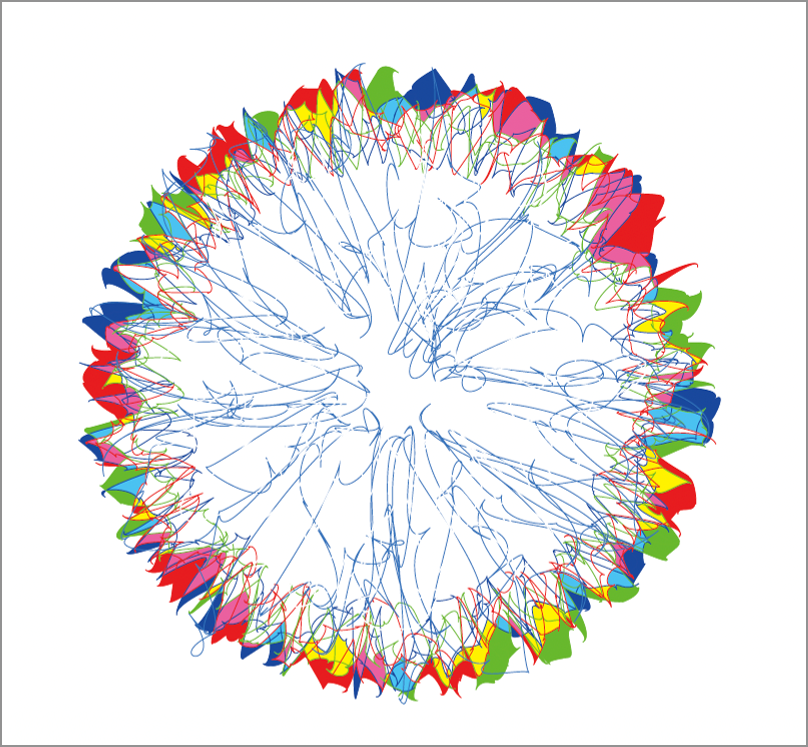
Q-Ring takes inspiration from the photon, the smallest unit of light and one of the basic particles in quantum physics. The work is composed of five closed lines representing the elements through which we perceive light: the three primary colors of light—red, green, and blue violet (RGB)—along with brightness and darkness. These lines loop and intertwine to form a ring, evoking a cosmos that flows continuously from the minuscule to the immense, while glimmers of colored light spill out around the edges. In keeping with the fundamental quantum principle of indeterminacy, the form is designed to shift slightly each time it is rendered.
A City Composed of Optical Illusions |Incidental Landmarks Entangled in Light and Perception
Optical Illusion Block Project
Tomoko Ohtani + Kazushi Maruya + Yuko Higaki + Sayumi Higo + Mieko Nakamura + Yuko Isogaya
2025
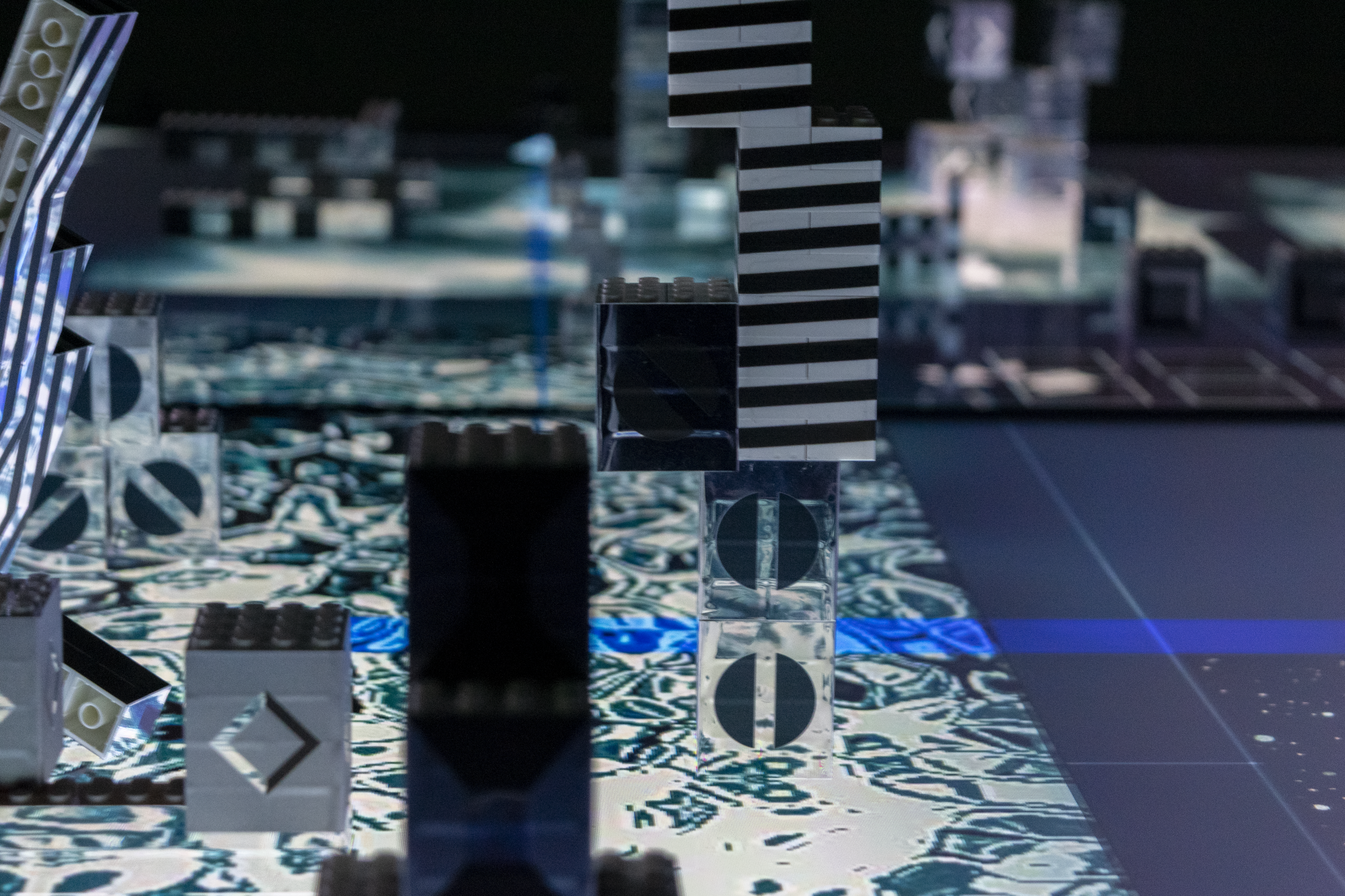
A group of researchers from diverse fields—psychology, aesthetics, and information engineering—together with designers, have created a work in which visitors can experience visual fluctuations through “optical illusion blocks” bearing a range of geometrical patterns applied to mirror-finished surfaces. Monitors embedded in the tabletops successively display video footage of the venue alongside abstract visual compositions inspired by each installation. Three-dimensional clusters of these blocks, placed atop the screens, appear to shift in form and gently sway—depending on the ambient light from the video, the viewer’s angle, and even their internal state of mind.
Our visual perception is full of subtle fluctuations that often go unnoticed. As you move through the exhibition, we invite you to become attuned to how your own perception may shift in response to these quiet visual tremors.
Cooperation: Nakagawa Chemical Co., Ltd., Art Media Center, Tokyo University of the Arts Department of Arts and Sciences, Faculty of Fine Arts, Osaka University of Art NTT, Inc. Communication Science Laboratories, National Institutes for Quantum Science and Technology (QST)
Superposition, Entanglement, Measurement - Saccade-Based Display
Hideyuki Ando
2025
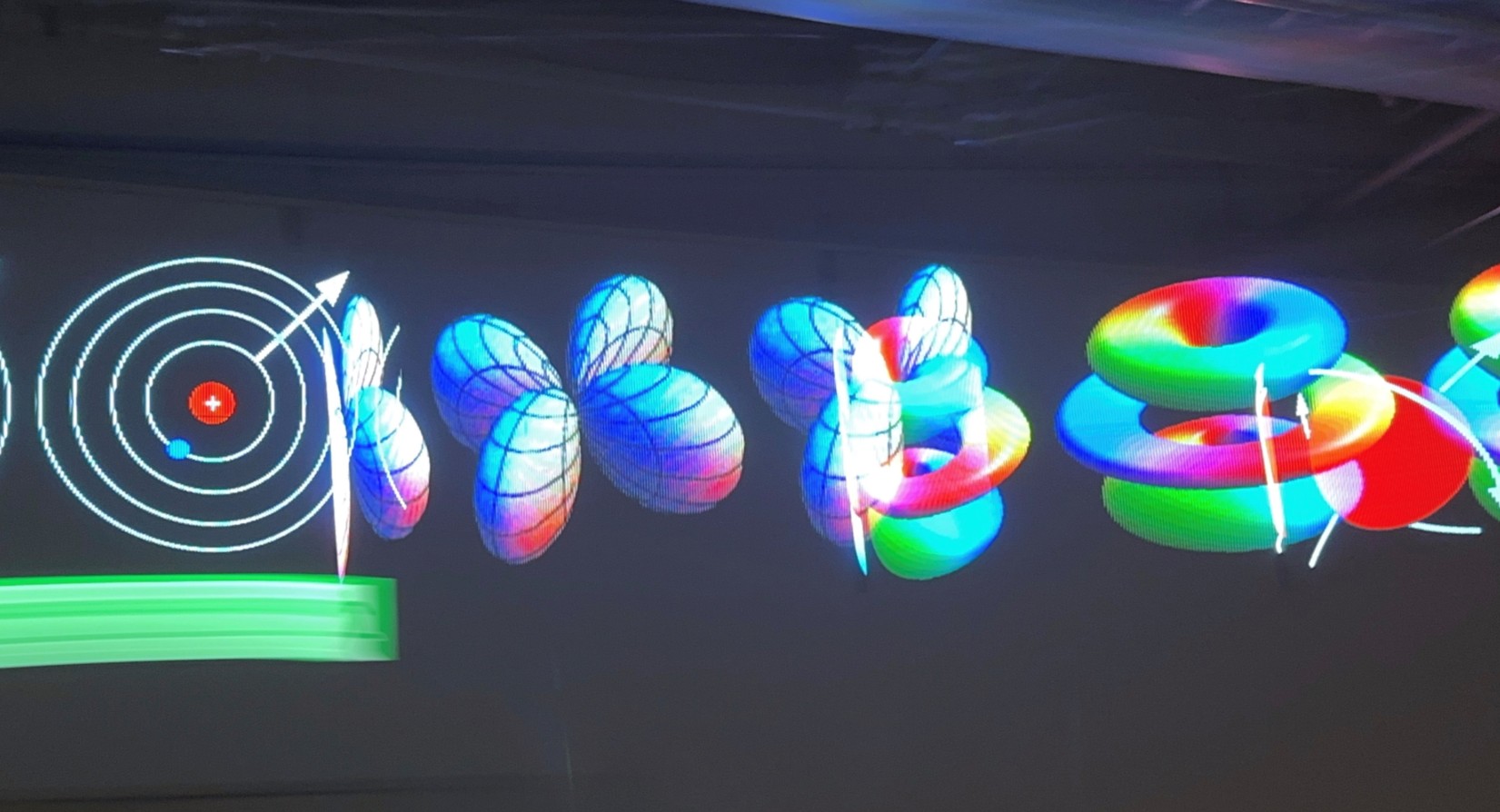
This innovative display system projects images in midair from a single column of LEDs by utilizing “saccades,” or rapid-eye movements. Try shaking your head or moving your eyes around to experience this phenomenon in which images appear to overlap and intertwine in space.
Cooperation:Shigenori Tanaka (Kobe University), National Institutes for Quantum Science and Technology (QST)
The Art of Entanglement
Yasuhito Nagahara
2025
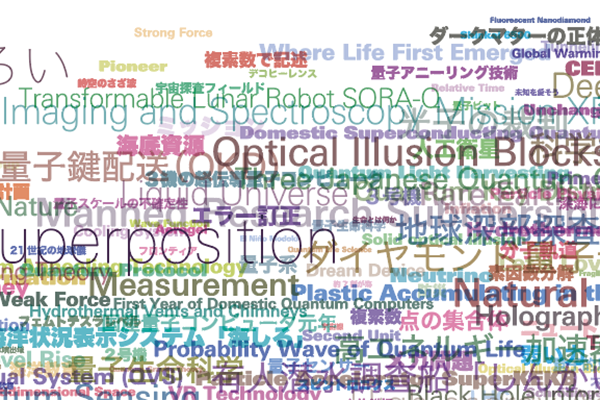
At the end of the prologue, a 6.6-meter-wide wall displays layers of keywords regarding to the exhibition. Each word has different size and color, their arrangements are determined by chance. Just as gas and cosmic dust scattered throughout space form nebulae, and as raindrops that fall from clouds to the ground return to the sky to form clouds again, those many words hide behind in the background of this exhibition are entangled here
1
Quantum Computer Art Studies
Akihiro Kubota
2025
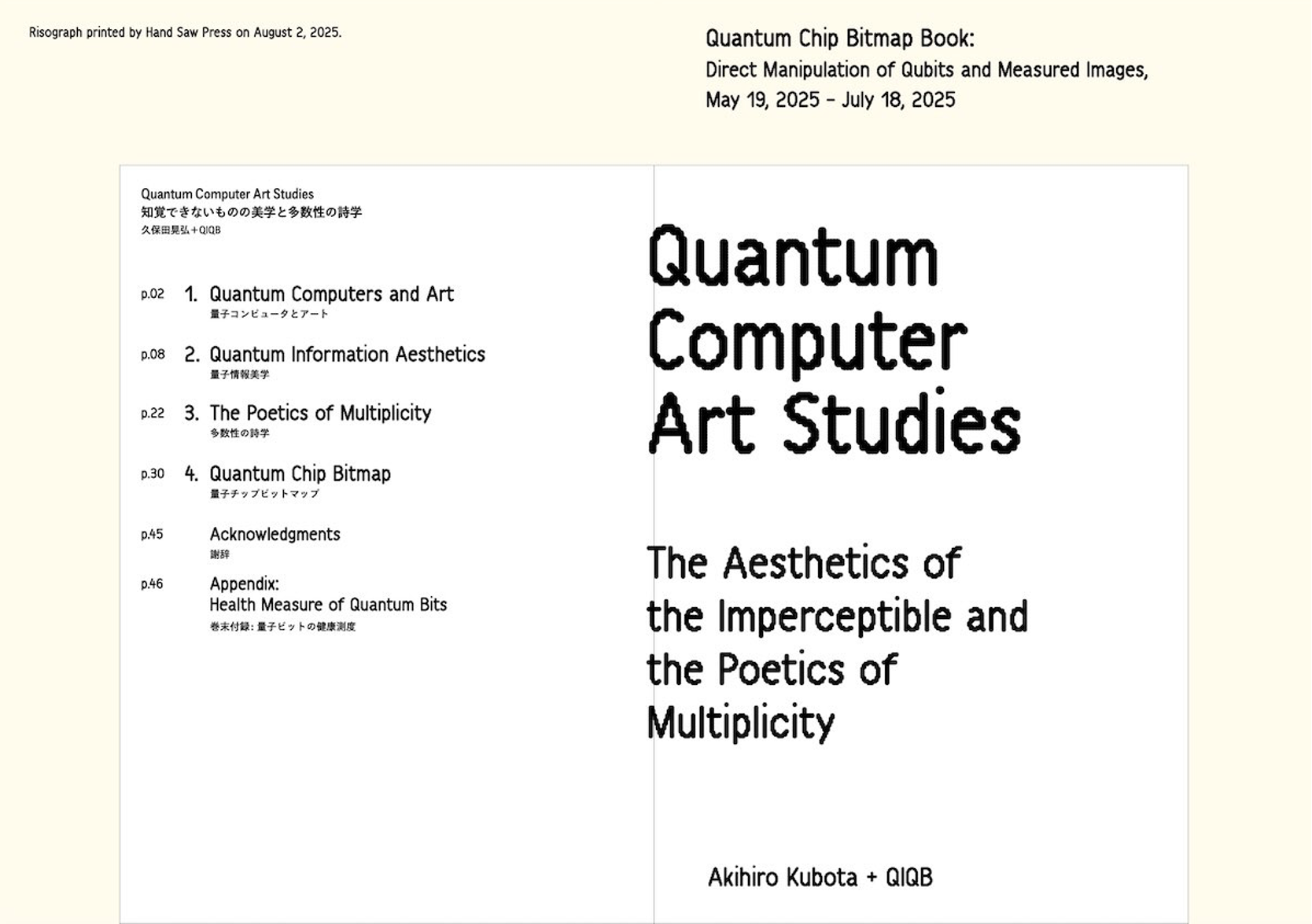
Quantum computers are “natural computing machines” that employ quantum phenomena—the fundamental behaviors of nature—as their underlying computational principle. By directly manipulating the imperceptible states of quantum particles, they emulate natural processes to perform calculations. The extension of this quantum computing framework to creative expression is known as “quantum computer art.” In this exhibition, we operate quantum bits using quantum gates on a chip cooled to near absolute zero at QIQB, The University of Osaka, thereby reinterpreting the quantum states on the chip as new aesthetic structures. Through this endeavor, where complex-number calculations intersect with material processes, we present two novel artistic frameworks: “Quantum Information Aesthetics” and “Quantum Chip Bitmap.”
*Complex numbers consist of both “real numbers” (ordinary numbers) and “imaginary numbers” (numbers whose square is negative). While real numbers are represented as points on a number line, complex numbers can be visualized as points that rotate or oscillate on a plane.
Cooperation: Center for Quantum Information and Quantum Biology, The University of Osaka, Makoto Negoro, Takafumi MiyanagaExhibition and Booklet production: Takahiko Azami, Yurie Hata, Chika Goto
Booklet Design: Yurie Hata Booklet Editing: Chika Goto
Exhibition Production: Takahiko Azami, Yurie Hata, Chika Goto
Risograph Printing: Hand Saw Press
2
Quantum Computer XR
RIKEN Center for Quantum Computing
Production: Rhino Studios Inc.
2025
This XR (extended reality) experience enables you to explore a superconducting quantum computer. Meticulously reconstructed from actual blueprints, the large-scale device can be taken apart by hand, layer by layer. As you remove the intricate wiring, components, and cooling systems, you eventually uncover a tiny chip at its center forming the heart of quantum computation. By picking up the chip and examining it at close range, you gain a tangible sense of the precision underlying this cutting-edge technology. A charming cat character explains how the quantum computer works, making the complex science accessible to all audiences.
3
multiplicity
Akinori Goto
2025
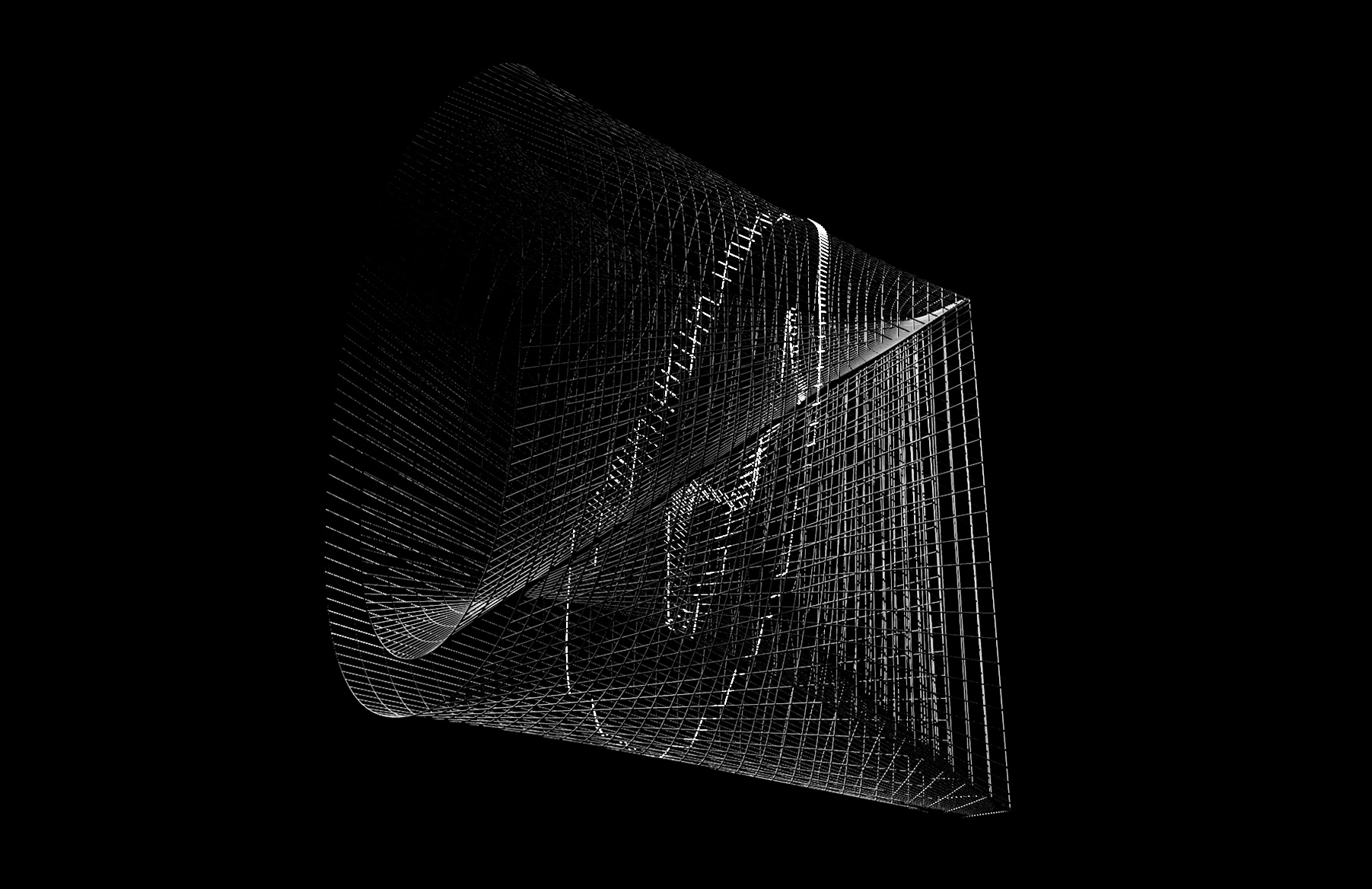
This work is inspired by a fundamental characteristic of quantum cryptographic communication: observation irreversibly alters the quantum state. Any attempt at eavesdropping or interference leaves a trace, making secure transmission possible. At its core lies a notion of information and existence that remains undefined until witnessed — emerging only through interaction. By visualizing the physical forms of 0 and 1 and the shifting light that moves between them, the work explores the ambiguity preceding certainty and the coexistence of multiple overlapping possibilities—behaviors unique to the quantum world.
3D Printing Assistance: DMM.make
Art Gallery
Appearance and Disappearance 2025
Takuro Osaka
2025
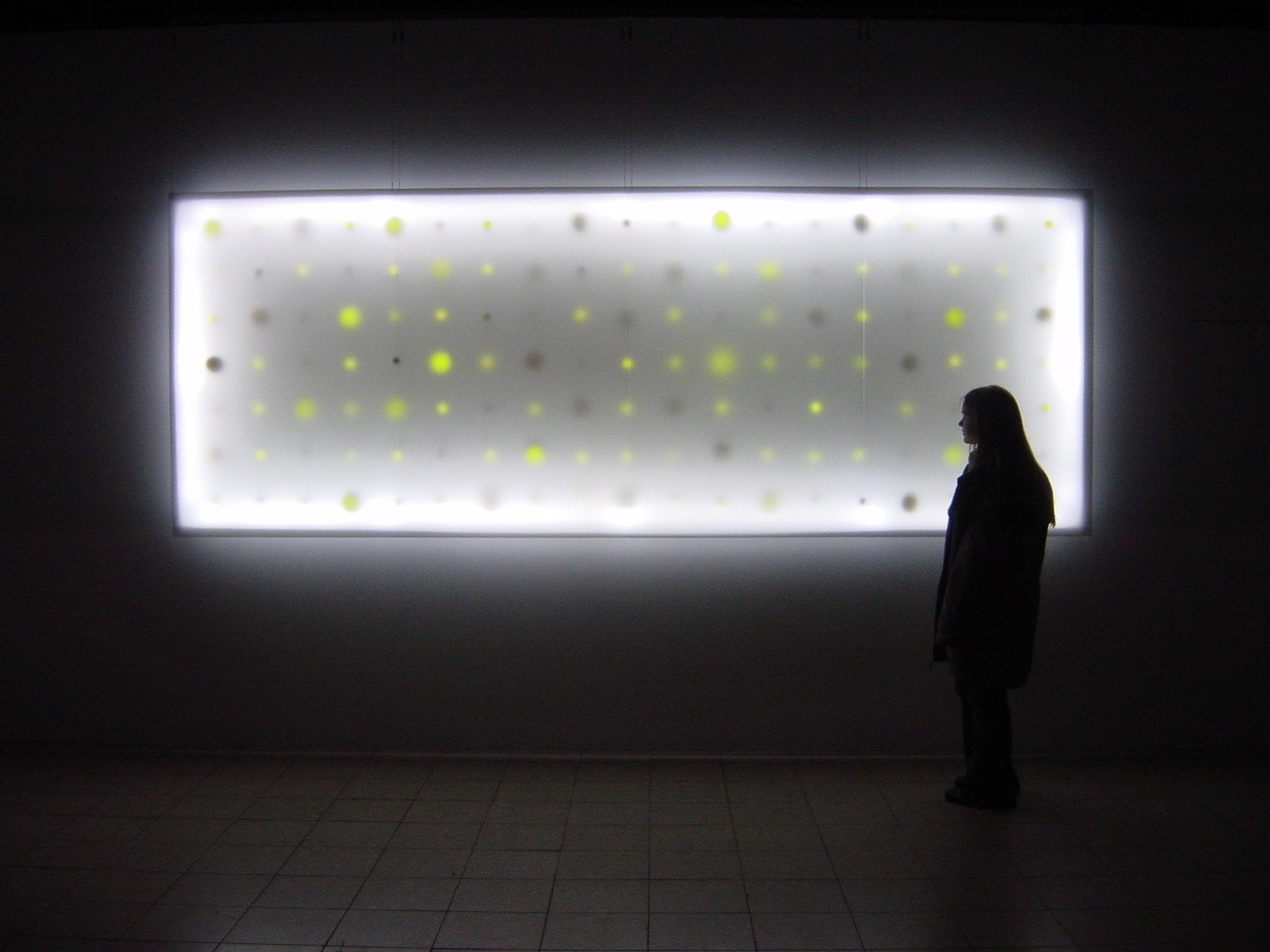
Scintillator, photomultiplier, amplifier, LED, neon, tent fabric, and mixed media
Cosmic rays like muons, generated by supernova explosions and constantly raining down on the Earth, are invisible to the human eye. In recent years, however, they have been used in archaeological surveys and rendered visible by detectors known as scintillators. This pioneering work evokes the birth and extinction of the universe and organic life. Each time an arriving cosmic ray is detected, an LED momentarily goes dark, leaving a momentary afterimage before gradually lighting up again. This work invites us to reflect on the invisible world around us, all while countless cosmic rays pass through us second by second.
Cooperation: Shinichi Kurata, technical director
datum
Norimichi Hirakawa
2016 / 2025
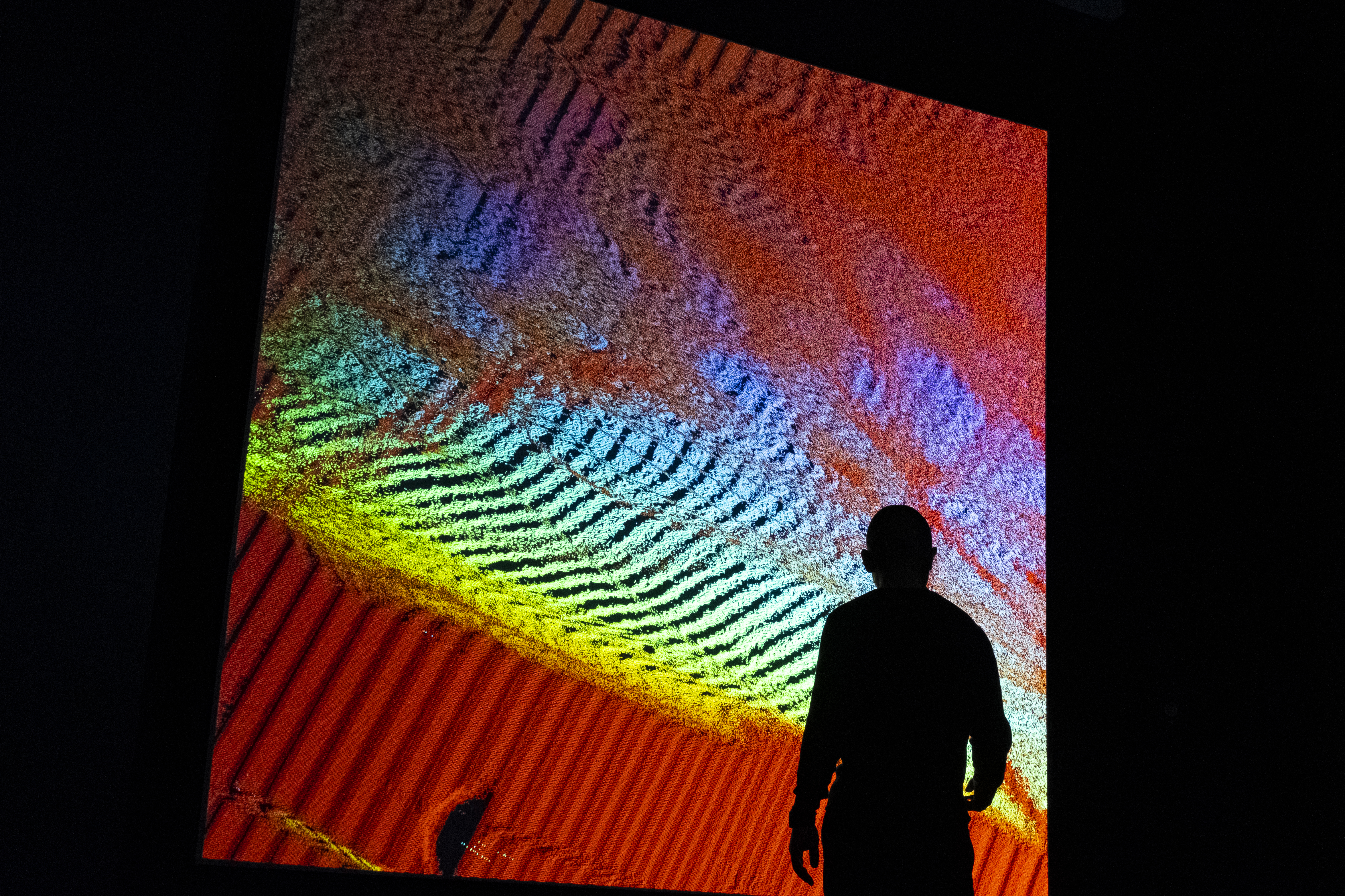
What sort of moving images might emerge if space, color, and time were treated as equal elements within a multidimensional structure? In this work, each pixel floats in a system of six-dimensional coordinates: space (X and Y), color (R, G, and B), and time (T, represented by the number of frames). As the image rotates, color tones and temporal curves merge into a continuous flow, eventually returning to their starting point of 0 degrees after a full rotation. The project grew out of an artist residency program* through ongoing conversations with researchers in string theory, particle physics, and theoretical physics.
*Artist residency at Kavli Institute for the Physics and Mathematics of the Universe (IPMU), The University of Tokyo Institutes for Advanced Study (2016)
Cooperation: Kavli Institute for the Physics and Mathematics of the Universe (IPMU)
Equipment Support: Fostex Company, a division of Foster Electric Co., Ltd.
4
The World of the Optical Quantum Computer
Koichiro Eto + ARARE STUDIO
2025
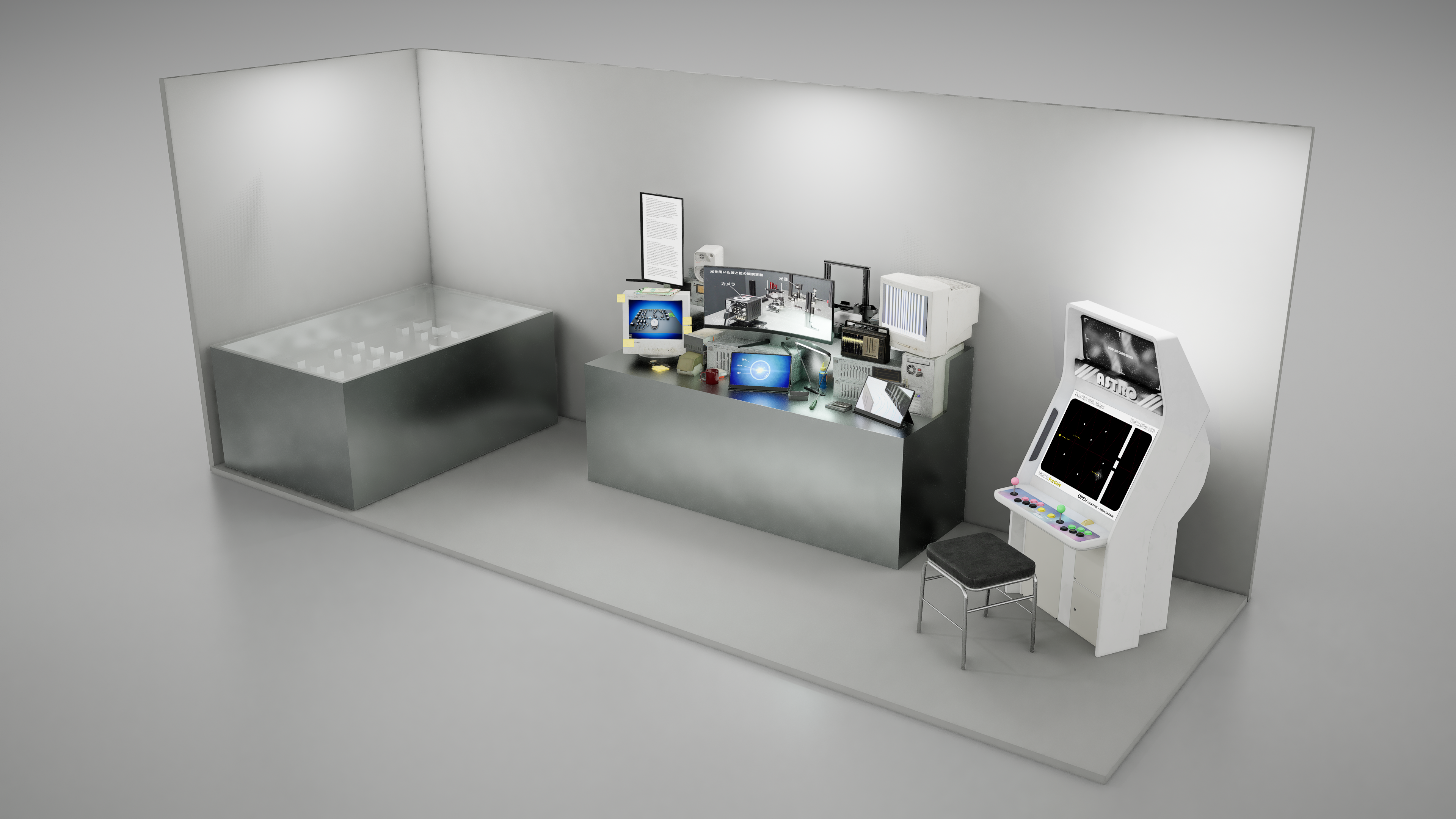
The theme of this exhibition is “The World of the Optical Quantum Computer.” A mock-up of an optical quantum computer stands in the center, surrounded by works that project footage of experiments related to the quantum nature of light, including Thomas Young’s double-slit experiment, on monitors from various eras. Visitors are invited to revisit quantum mechanics through sensory experience, encountering its history and the quantum realm, where multiple states coexist probabilistically, and glimpsing the future envisioned by the optical quantum computer.
Video courtesy of Hamamatsu Photonics K.K.
Mock-up production: OptQC Corp.
Cooperation: National Institute of Advanced Industrial Science and Technology (AIST)
5
Character Design: Mitsuko
Masayuki Inoue (Pantograph)
Illustration: Neki Inc.
2025

Mitsuko is a character based on Mitsuko Namino from The Trial of the Photon (Mitsuko/Koshi no Saiban) by Shinichiro Tomonaga. Mitsuko was designed by Masayuki Inoue, a member of the artist unit Pantograph, which specializes in three-dimensional modeling and stop-motion animation. With a look that hints at mid-century modern design, Mitsuko offers clear and engaging explanations of the exhibition’s central themes, including quantum entangled photons, two-photon quantum interference, and the violation of Bell’s inequality.
6
Diamond Quantum Sensors /Installation using TMR sensors, and Spin-MRI
Production: Siro Inc.
2025
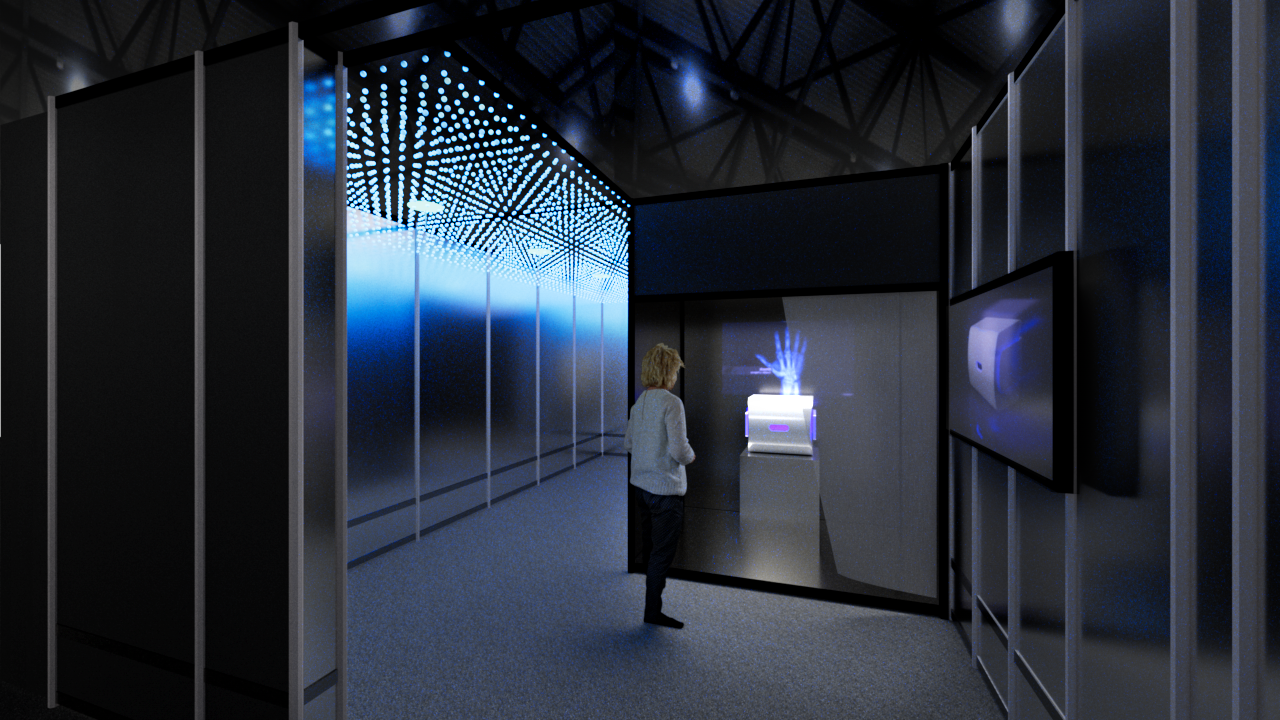
Siro Inc., whose work spans planning, prototyping, and development, and extends from engineering-based problem-solving to realization of imaging systems, presents an exhibit developed at the Institute of Science Tokyo that uses design to explore themes such as “quantum × light” and the subtle presence of quantum behavior in everyday life. In addition the company presents a real-time installation that uses light and sound to sensitively detect changes in spatial magnetic fields, using quantum spin sensors (TMR sensors). The exhibit also features a hands-on display of a compact, room-temperature MRI device that applies quantum sensing, developed in collaboration with Tohoku University.
Diamond quantum sensors|Cooperation: SIP3 Quantum “Promoting Application of Advanced Quantum Technologies to Social Challenges” (Cabinet Office), Q-LEAP(MEXT)
Installation using TMR sensors, and Spin-MRI|Cooperation: SIP3 Quantum “Promoting Application of Advanced Quantum Technologies to Social Challenges” (Cabinet Office)
7
Blinking Quantum Life
Hideyuki Ando + Shigenori Tanaka
2025
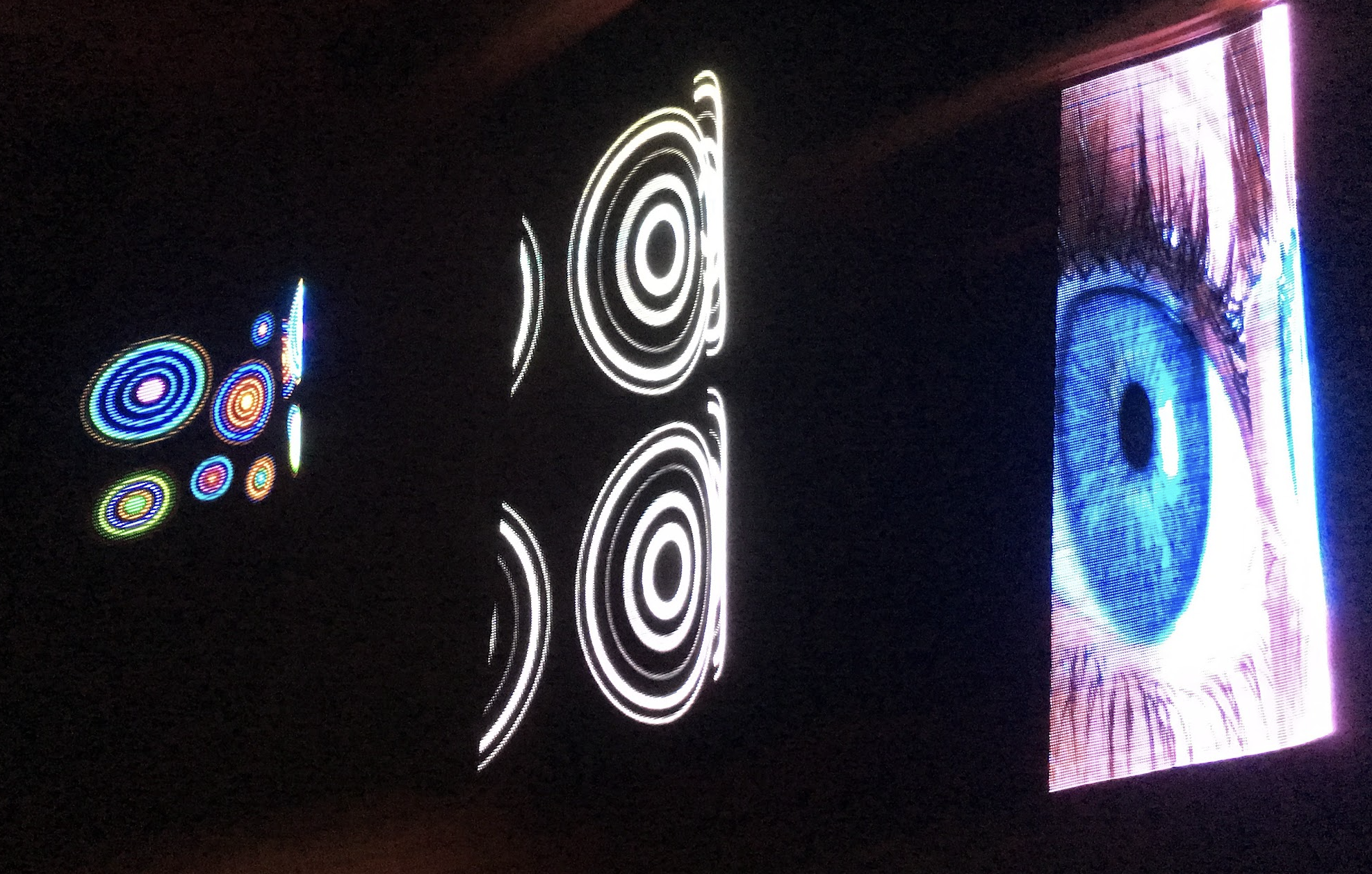
This artwork is composed using a special display method called “Saccade-based Display.” It works by rapidly flashing a single column of light during quick eye movements to show two-dimensional images. As if “observing” quantum effects in biological systems*, the observer’s face, eyes, and molecular-level structures governing vision are expressed, representing the quantum interaction between seeing and being seen. While gazing at images that appear only in moments of blinking or turning your head, let us contemplate the act of “observation.”
*In some biological molecules, quantum states of electrons, protons, and spins exist in moments where they spread “wave-like,” and their probability distributions are thought to optimize energy transport and chemical reaction selectivity within living systems. These phenomena are collectively called quantum effects in biological systems.
Cooperation: National Institutes for Quantum Science and Technology (QST)
8
Mid Tide #3
Ryu Furusawa
2024

Staring at the slowly changing seascape and the movement of the waves, we are surprised to see its expression changed dramatically, after a while. Waves shot in the same location over a long period of time laps, show not just the ebb and flow of the tide, but the overlapping “layers of time” in the direction of depth. When the flow of time is “observed”, cut out and superimposed, various scenes are revealed towards us. It is a kind of different experience, differs from the flow of time as we know it. Let us consider the wonder of “observation” which transcends time and space.
Equipment Support: Sony Marketing Inc. (BRAVIA 8 K-77XR80)
Support: Project to Support Emerging Media Arts Creators
Tangible Earth (Sphere)
Shinichi Takemura
2025
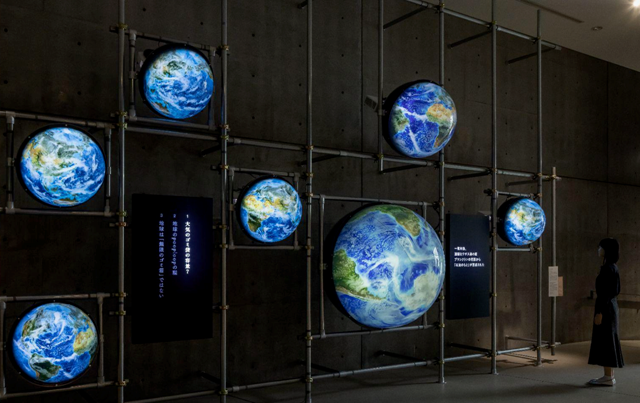
Tangible Earth (Sphere) is the interactive globe which shows the “living Earth” in real time with a variety of visual movements. It visualizes clouds and typhoons captured by satellites, live images of cities around the world, continental drift over hundreds of millions of years, global warming, and many other data, bringing into our Earth as an “oasis in the universe.” When we look at it again from the perspective of the universe, we can feel the colorful variety of life there.
The Drifting Tetralemma: Sea, Sky, Vessel, and Body
Yoichi Ochiai
2025

photo by Yoichi Ochiai
In 2024, media artist Yoichi Ochiai embarked on the French “scientific exploration ship Tara,” a scientific exploration of the world’ s oceans for the purpose of preserving marine life and the environment. In addition to photographic works inspired by the voyage, he has photographed many ocean-related objects and printed them by platinum prints, a method which is so stable photographic technique remaining indelible for hundreds of years. In the deep gradation of his work, he quietly captures moments that are constantly changing.
Tara Europe Project
Ocean, Sway, Waves, and Preparing Tea
Yoichi Ochiai
2025
While aboard the scientific exploration vessel Tara, Ochiai considered about the “shaking,” which was different from our usual life, and released his “Tara Diary” on the Internet. In it, he wrote about “shaking with a frequency lower than that felt by the eardrums” and “the shaking of the ship and the hills. Also, his appearance on a live news TV program, on his work with the computer on the ship, which was rocking greatly, attracted widely.
*On August 16th, the experiment at this venue, in which visitors can actually feel the state of “shaking”, together with an artist talk.For more details, please check the stage program on the website.
Liquid Universe II
Yoichi Ochiai
2024
Liquid Universe is a work that uses generative AI to express the changes of all things and their relationship to each other. Based on Ochiai’ s concept of “Digital Nature,” the AI-based moving images are constantly changing, as if seamlessly connecting the boundaries of tradition and innovation, mystery and science, material and immaterial, and marine life and dragons are born and disappear. The world’ s ebb and flow, without beginning or end, seems like as “Ouroboros serpent” connecting the quantum, the ocean, and our universe.
Provision of equipment and technical cooperation:SEIBIDOU
9
SORA-Q
Joe Nishizawa
2022 / 2025
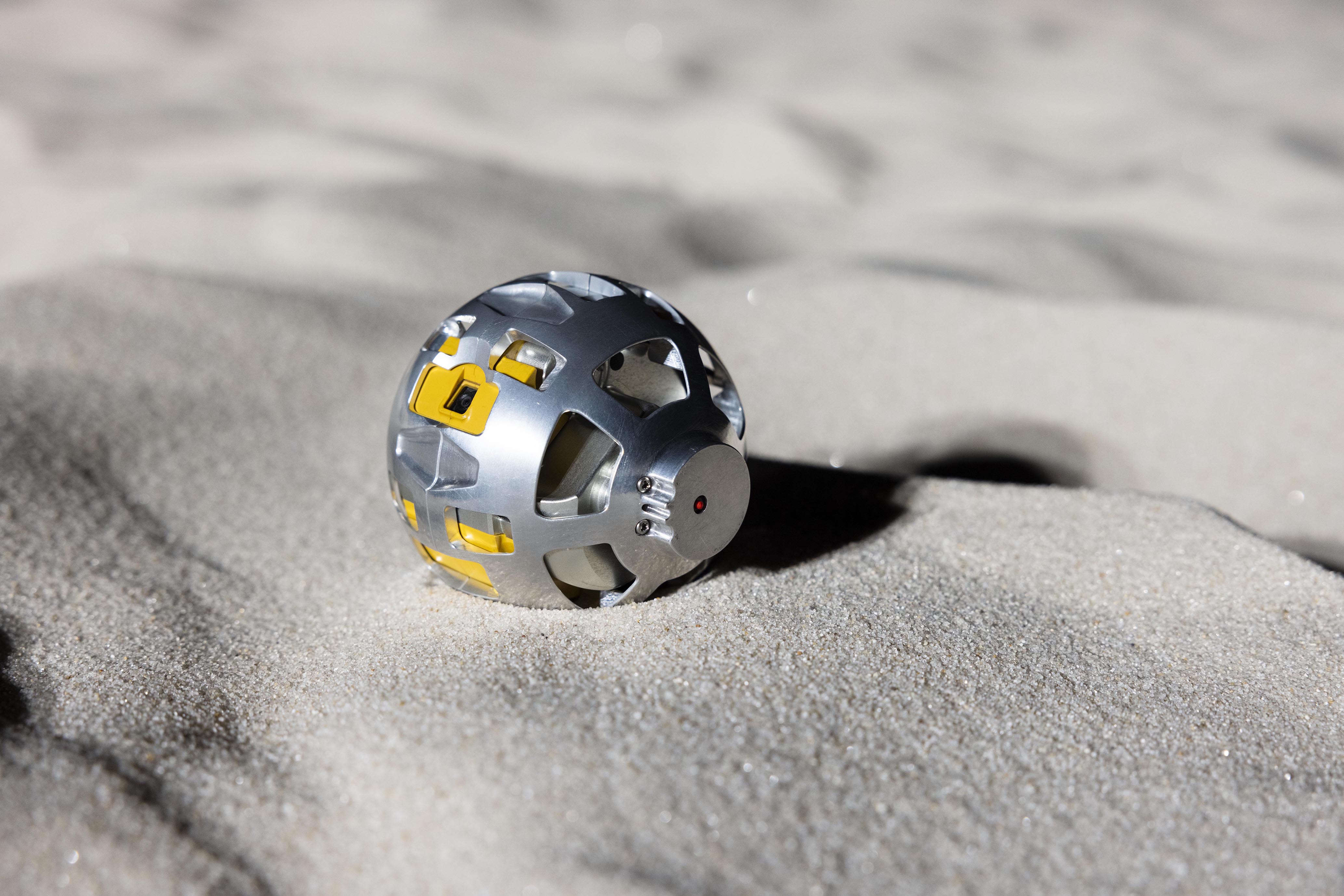
Joe Nishizawa has photographed space rockets, gigantic accelerators, steelworks, and nuclear fusion facilities. His work is based on the concept of “visualizing the invisible” by photographing imperceptible images with a microscopic transformable lunar robot called SORA-Q to document the turning point in Japanese space development. Nishizawa’s approach of constantly posing questions—such as “Is the subject useful to society?” and “Is there any reason to photograph it?”—is manifested in his work.
Cooperation: Japan Aerospace Exploration Agency (JAXA)
ANREALAGE 2022-23AW COLLECTION
PLANET
ANREALAGE
2022
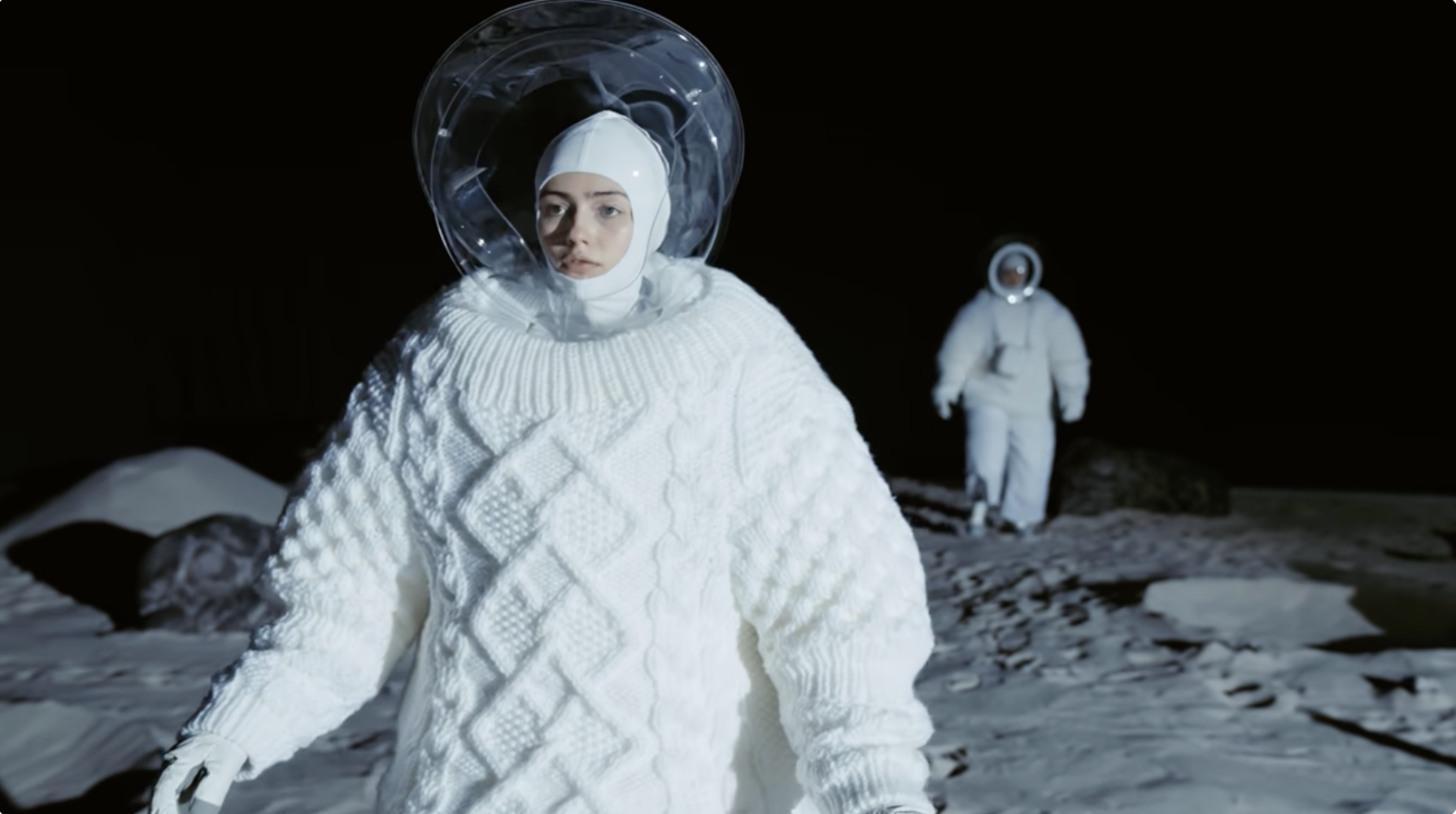
The theme of ANREALAGE’s 2022-2023 Autumn/Winter Paris Collection is “PLANET.” After shooting video footage at the Space Exploration Laboratory on JAXA’s Sagamihara Campus, the artist released the show on the Paris Collection’s digital platform. The Space Exploration Laboratory contains a space exploration field in which silica sand, designed to simulate regolith, is spread over the surface topography, and an experimental facility is used to simulate the lighting environment of the moon and planets. The field is normally used as a base for research and development on space exploration, and to conduct experiments on probes. The costumes were designed to withstand the harsh environment of space with aerogel, a material developed by NASA for space suits that provides insulation at temperatures as low -196°C, and to provide a preview of space fashion in the future.
Cooperation: Japan Aerospace Exploration Agency (JAXA)
Space Art Tanegashima

footage from 2017, 2018, 2023, 2024
The Space Art Tanegashima is an event that presents art in the unique setting of Tanegashima Island, where lush natural landscapes meet Japan’s leading space exploration hub in Kagoshima Prefecture. Preliminary events began in 2012, ahead of the first full-scale festival in 2017. In 2023, the Light Festival was launched, featuring nighttime exhibitions of light-based art and performances. The 2024 edition took place from November 1 to December 8 with the theme of “love of the unknown” with 16 leading artists from Japan and abroad presenting works in three locations: the lawn of the Tanegashima Space Center (the country’s largest rocket launch facility, located in Minamitane-cho in southern Tanegashima), the town center, and a coastal cave area.
Organizer: Space Art Tanegashima Executive Committee
Co-organizers: Minamitane Town, Minamitane Town Board of Education, Minamitane Town Chamber of Commerce, Minamitane Branch of Minamitane Town Tourism Association, Minamitane Town Settlement Promotion Executive Committee, Tanegashima University Executive Committee
Cooperation: Japan Aerospace Exploration Agency (JAXA)
KEK Reinterpretation Model Group
Junya Kataoka + Rie Iwatake
2025
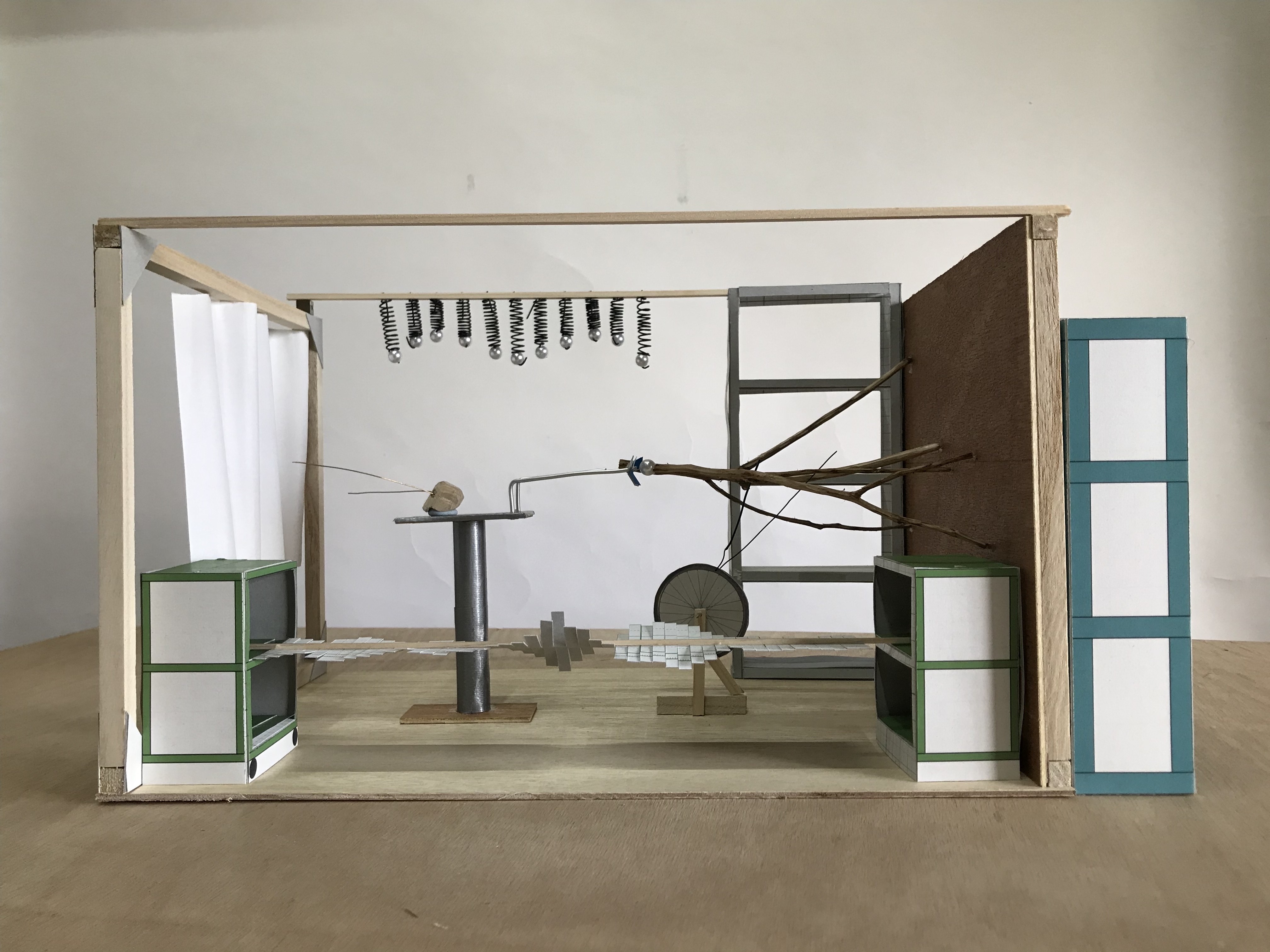
Maquette for KEK Reinterpretation Model Group
This work was produced during a one-month residency at the High Energy Accelerator Research Organization (KEK) by two artists who collaborate as a unit, both in Japan and internationally. During their stay, they interviewed 28 researchers and toured 14 facilities. Iwatake focused on how complex phenomena such as string theory and fluid mechanics are expressed in two-dimensional diagrams, exploring underlying modes of thought and visualization. Kataoka produced works based on Fleming’s left-hand rule, applied in high-energy accelerators, as well as the Misinterpretation Models series, which reimagines the relationships between waves, particles, and forces. Their approach dissolves the line between art and science, and between seeing and being seen, treating these as fluid, interpenetrating relationships. Drawing on the Japanese tradition of “mitate Äi0(seeing one thing as another)”, the artists cause these domains to layer and intersect, allowing new and unexpected dimensions of meaning and expression to emerge.
*Created as part of the Artist-in-Residence program at the High Energy Accelerator Research Organization (KEK) and the Tsukuba Science Hackathon 2025, hosted by Tsukuba City, Ibaraki Prefecture.
Cooperation: High Energy Accelerator Research Organization (KEK), Tsukuba City, Ibaraki Prefecture
Each of us is made of particles/In Pursuit of the World’s Best Accelerator
Ken Yokoi
2006
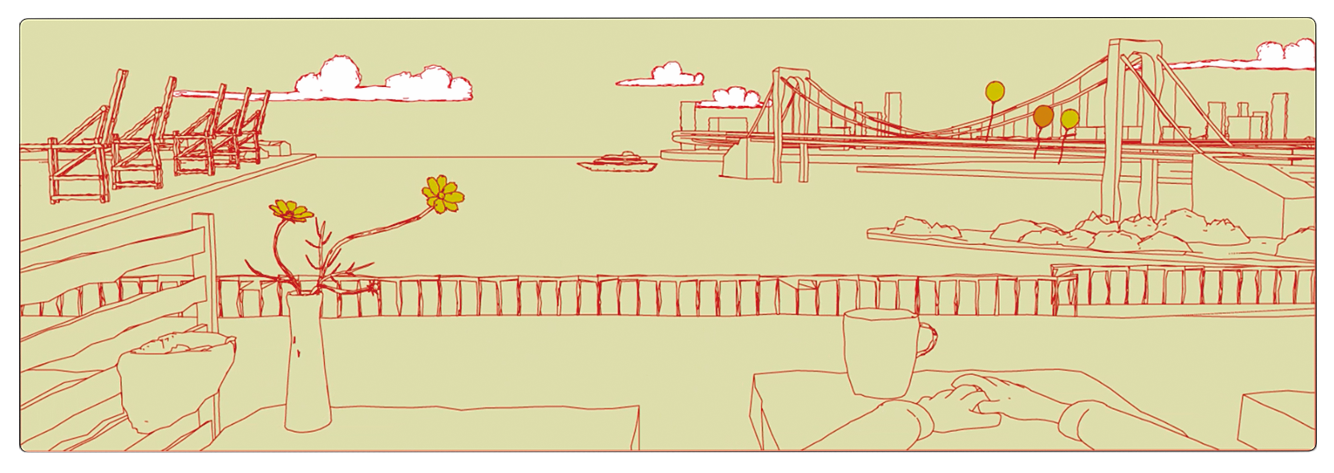
In this work, our viewpoints become tiny elementary particles, and are sucked into the KEKB particle accelerator, located underground at the High Energy Accelerator Research Organization (KEK) at the foot of Mount Tsukuba. Inside the ring-shaped tunnel, elementary particles emerge that are born when electrons and atomic nuclei are accelerated to nearly the speed of light and collide head-on. Meanwhile, an animated presentation, Each of Us Is Made of ParticlesÄi0*, depicts the essence of mysterious elementary particles and the laws of nature in everyday scenes.
*Until January 2025, this work was displayed as “The Study of Elementary Particles and the Universe with a Particle Accelerator,” one section of Exploring the Frontiers, a permanent exhibition at the Miraikan (5F).
Video Courtesy of Miraikan - The National Museum of Emerging Science and Innovation
Universal Times
Hiroyuki Moriwaki
2025
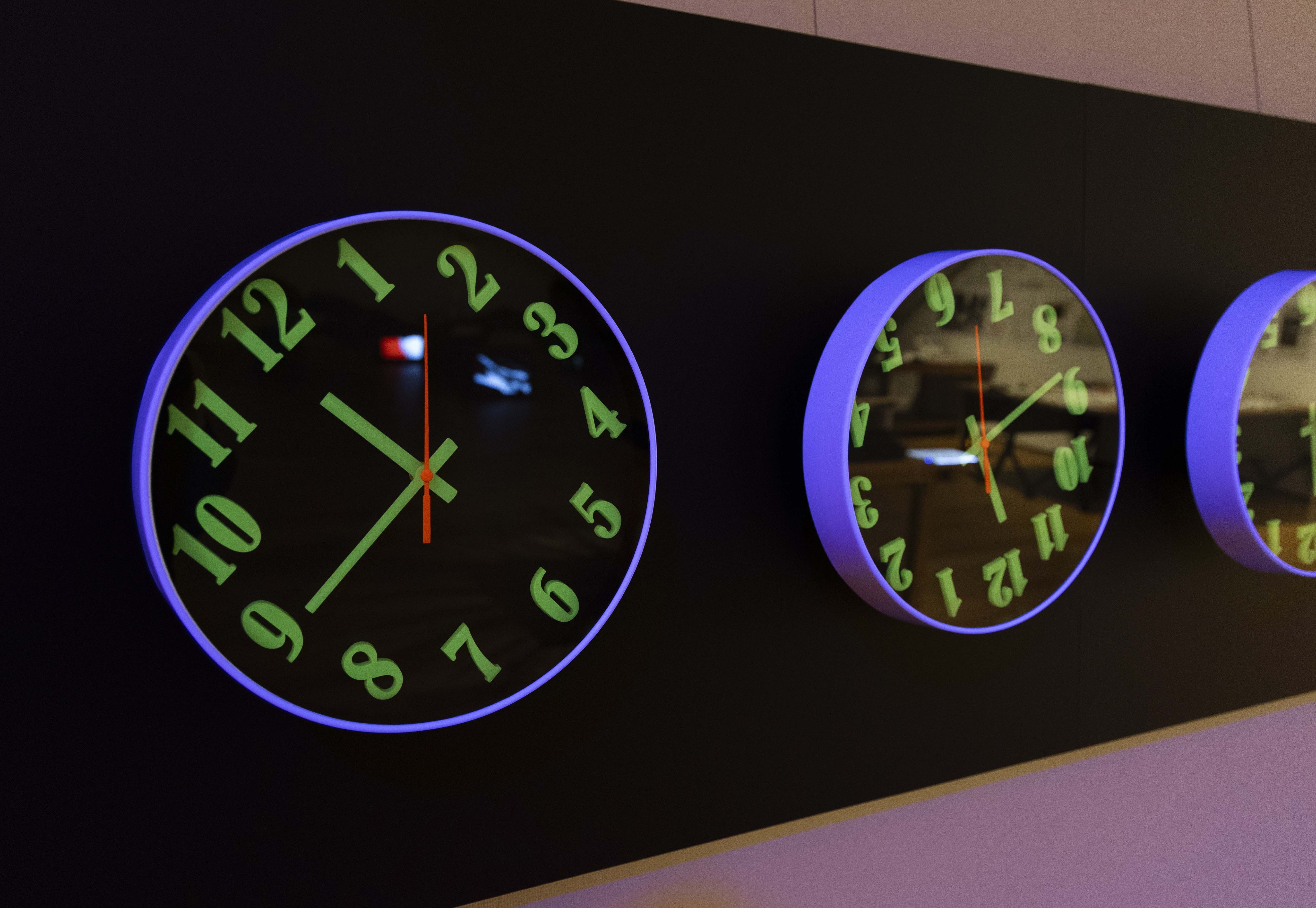
Albert Einstein’s theory of relativity proposed that there is no absolute yardstick for space or time, sweeping away long-held assumptions and opening the door to completely new ways of thinking and assigning value to the world. Universal Times is a work that uses wall clocks to visually explore distorted time axes and the concept of time as a relative phenomenon. As you look closely, consider the meaning of the title and how time might be understood as not fixed but fluid.
Black Hole Recorder
Useless Prototyping Studio
2021
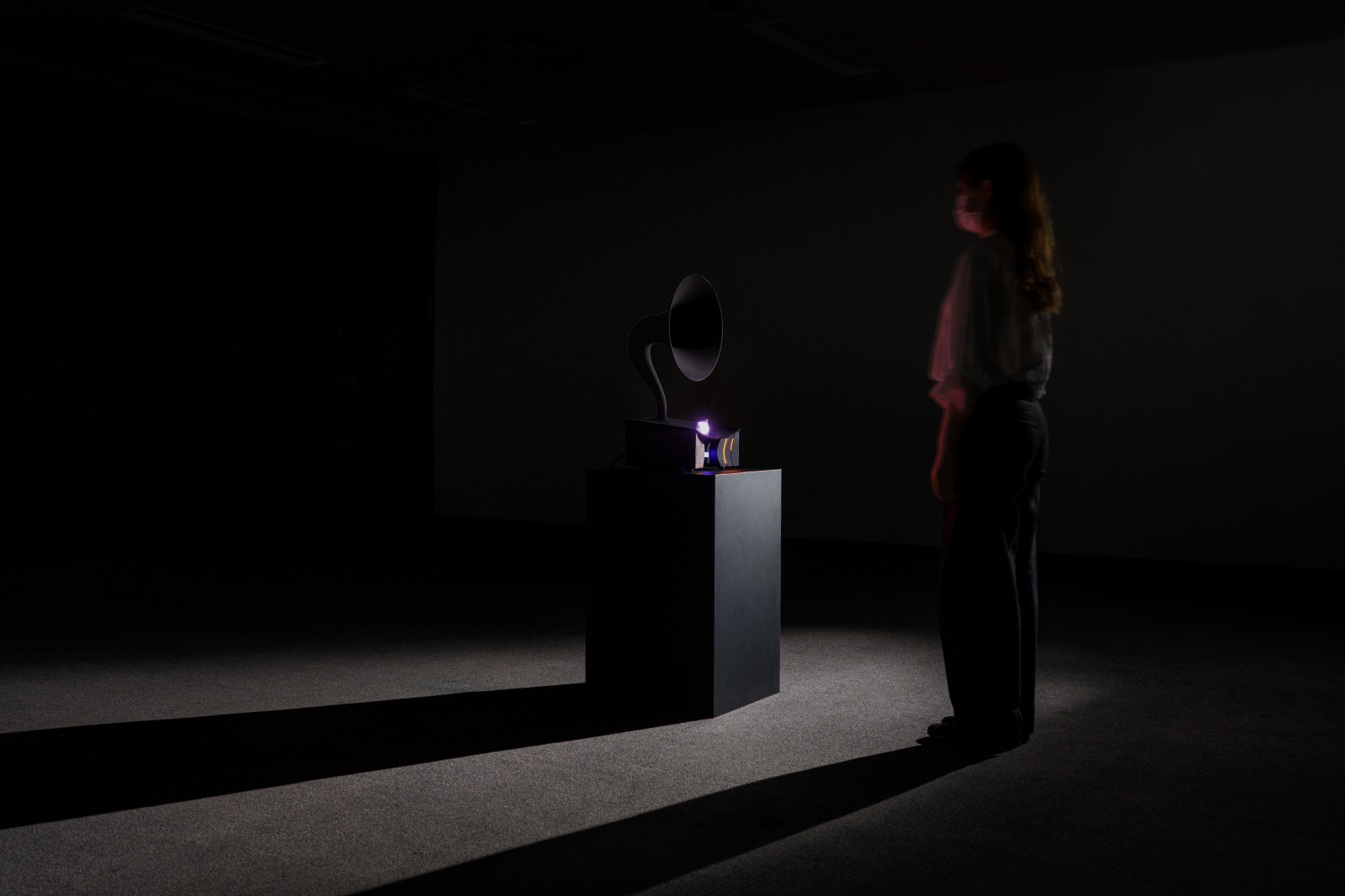
Black Hole Recorder is a fictional design product: a gramophone-shaped information storage device equipped with a miniature artificial black hole. The result of fictional black hole engineering, the device captures sound through a horn inspired by the warped spacetime of a black hole, and imagines the capacity to store approximately 10 to the power of 52 gigabytes of data.
Drawing on the black hole information paradox in quantum physics, the work invites us to imagine a future in which our voices might one day be preserved within a real black hole somewhere in the distant universe.
Note: This work was inspired by a research paper proposing that information swallowed by a quantum black hole would eventually be released as the black hole evaporates. While on display, the device is constantly recording and capturing all of the surrounding sounds as information.
Production: RIKEN Center for Interdisciplinary Theoretical and Mathematical Sciences (iTHEMS), ADK Marketing Solutions Inc., ADK Creative One Inc., Tailor Innovations Inc.
Epilogue
A City Composed of Optical Illusions|Reflecting on the Exhibition Experience
Optical Illusion Block Project
Tomoko Ohtani + Kazushi Maruya + Yuko Higaki + Sayumi Higo + Mieko Nakamura + Yuko Isogaya
2025
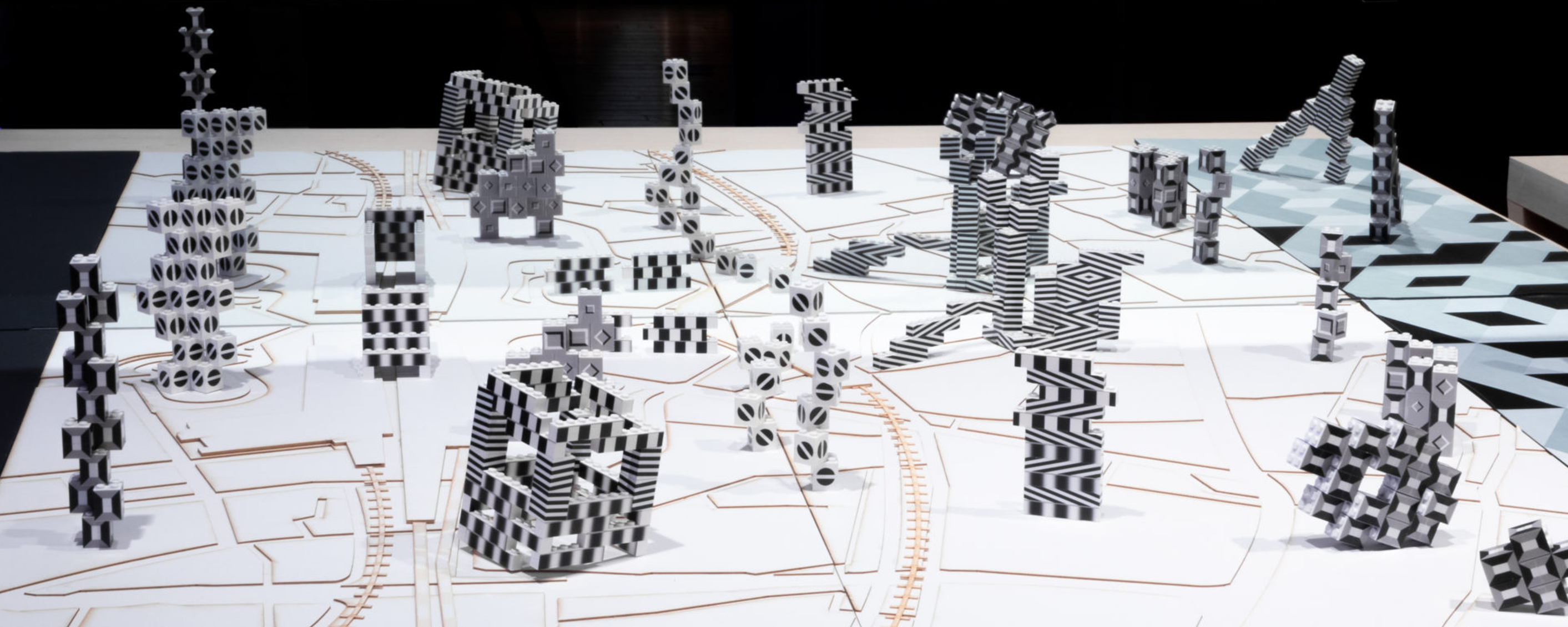
ⓒ Optical Illusion Block Project,Photo by Kenji Agata
In this corner, visitors are invited to share their experience of the exhibition by arranging optical illusion blocks. Recreate a memorable scene and place it on the venue map to see it from a new perspective.
Production Cooperation: Yutaro KAWADA
Cooperation: Nakagawa Chemical Co., Ltd., Art Media Center, Tokyo University of the Arts Department of Arts and Sciences, Faculty of Fine Arts, Osaka University of Art, Communication Science Laboratories, NTT, inc. National Institutes for Quantum Science and Technology (QST)
